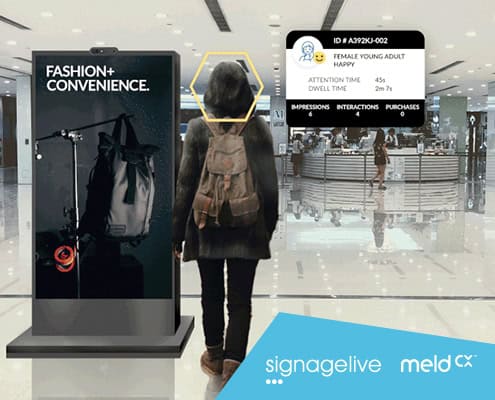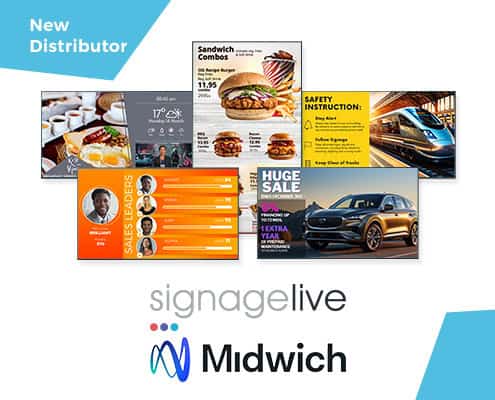You’ve probably noticed the colossal Digital Signage billboards that are dwarfing the people – and the streets beneath them, not to mention the glitzy giant videowalls that are now must-haves in every department store, and lobby entrance. But if you think that Digital Signage is just lavish digital bling for big brands and mega-entertainment industries, think again. The real digital revolution is happening quietly, right now, within the walls of businesses, showrooms, manufacturing plants, locker rooms and training facilities. So, just what are these Digital Signage developments, and why should CEOS and solutions architect take note?
Put simply, as Dave Haynes, Digital Signage expert and celebrated Sixteen: Nine founder and editor, points out, the real return on investment in the Digital Signage industry is how its improving “effective communications with customers and staff”. This is having a real-world impact, enabling businesses to perform better, attract more talent, smash targets and boost efficiency as well as their bottom lines.
Sensor-driven Digital Signage
You don’t have to look far to see some uses of practical Digital Signage in action. From airport terminals to train stations, sensor-driven Digital Signage is being installed to improve the commuter experience, whether that’s by advising on which queues are faster-moving, and where to find them, or to help locate available seats in train carriages.
Similarly, since the pandemic, the hybrid model of business has given rise to the phenomenon of hot desks, and consequently Digital Signage has been integral in helping staff, now merely infrequent visitors to the office, locate where they can and can’t sit.
Meeting room signage
Meeting room Digital Signage now does so much more than enable you to book and check the availability of meeting space. It’s becoming much more sophisticated, offering, for example, usage rates for rooms to help inform, streamline and improve operations and facilities management.
Deskless workers
So-called “deskless workers” in manufacturing plants and logistics facilities are also increasingly benefitting from the implementation of Digital Signage. It’s now a great way for language barriers to be crossed, allowing for the broadcast of information in any popular second language, such as, for example, Hispanic in the US and Canada.
Automated auditing and compliance
What’s also now becoming increasingly common for onboarding and training via interactive Digital Signage is automated auditing, which verifies that new hires have watched the necessary training programmes to pass their health and safety certifications.
With the latest generation of Digital Signage solutions, on-screen training content can be triggered at the touch of a button, and Digital Signage data can be used to prove that the training material was seen on a certain date. It’s an important way to streamline the onboarding process and helps ensure that new joiners can jump into their new roles much more quickly.
Buildings
Additionally, it’s worth noting that Digital Signage is becoming increasingly integrated with building systems, from HVAC to emergency notification systems. This is helping to boost the efficacy of health and safety protocols. If, for example, a carbon monoxide leak is detected, you can now use your Digital Signage to automatically alert staff, and orchestrate an emergency evacuation, with directions on the best way out of the building.
More than this, the digitisation of building environments is helping to market organisations and attract talent. You can already see the value of this in the college campuses of universities in the US, particularly in the marketing of their sports and training facilities for recruitment to football and basketball teams. Touches like lockers, personalised with individual Digital Signage screens, that display player names and individual messaging, are, in the words of Haynes “very, very powerful” marketing tools.
As Haynes says, the corporate sector is now using Digital Signage similarly, “blinging out” office buildings, as they’re having to “compete on the environments they present” to attract the staff they want.
The future of functional Digital Signage
So, with all the anticipated leaps and bounds in innovation, what will the functional Digital Signage market look like in five – ten years? Haynes predicts, that as buildings are designed, Digital Signage will become a “stitched in” feature of how they seamlessly operate. The display tech itself will become part of the design, with, for example, LED canvases, and in places like airports, big glass curtain walls that can be used to feature up-to-the-minute content. LED panels are already being built behind ultra-thin wood veneers or metallic material and are becoming part-and-parcel of lobbies.
Content form
What about content automation and form? Well, according to Haynes, while automated content, like, for instance, automated video content production hasn’t taken off yet, he believes there is already a market for AI-driven hyper-localised versions of campaigns. This is especially the case in the digital out of home market, where such localised AI generated advertising can be used to appeal to different geographical areas and/or even specific neighbourhoods.
Top tips for Digital Signage adoption
The benefits of straightforward Digital Signage for business are clear, and the trend for its adoption shows no sign of slowing down. But, Haynes warns, that’s no reason to jump in without first understanding exactly what you hope to achieve with Digital Signage. Why do you want to install it?
A Digital Signage consultant and professionally trained journalist, Haynes advises that before investing in any Digital Signage, consider the five W’s –
- Why are you doing this?
- What are you trying to achieve?
- Where is the Digital Signage going to be installed?
- When is it required by?
- Who is going to manage the installation, and then manage the content?
Content creation
Related to this, Haynes recommends that content should be carefully considered and planned. What’s genuinely going to make your target audience look up at your screens?
Too many companies believe that they can rely on the display of content, such as weather forecasts and traffic updates alone, when in reality, these are readily accessible from any Apple or Android app library.
Design layouts
Split-screen layouts enable you to display multiple pieces of content and appeal to more people. However, less is more, explains Haynes. The priority is that people can actually see and make sense of the on-screen content. It shouldn’t read like an “eye chart” and require the use of “binoculars” just to make out what’s on-screen.
Content duration
Remember, as Haynes says, “You’ve got like blinks to get information across to people.” Keep content short, preferably no more than a couple of seconds.
Tune into Digital Signage Explored to find out more about the latest trends and tips for Digital Signage in real-world businesses click here





You must be logged in to post a comment.